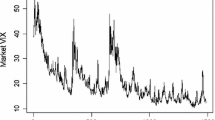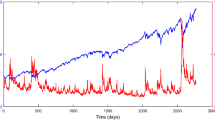Abstract
Being able to generate a volatility smile and adequately explain how it moves up and down in response to changes in risk, stochastic volatility models have replaced BS model. A single-factor volatility model can generate steep smiles or flat smiles at a given volatility level, but it cannot generate both for given parameters. In order to match the market implied volatility surface precisely, Grasselli introduced a 4/2 stochastic volatility model that includes the Heston model and the 3/2 model, performing as affine and non-affine model respectively. The present paper is intended to further investigate the 4/2 model, which falls into four parts. First, we apply Lewis’s fundamental transform approach instead of Grasselli’s method to deduce PDEs, which is intuitional and simple; Then, we use a result derived by Craddock and Lennox using Lie Symmetries theory for PDEs, and the results are more objective and reasonable; Finally, through adopting the data on S&P 500, we estimate the parameters of the 4/2 model; Furthermore, we investigate the 4/2 model along with the Heston model and the 3/2 model and compare their different performances. Our results illustrate that the 4/2 model outperforms the Heston and the 3/2 model for the fitting problem.








Similar content being viewed by others
References
Baldeaux, J., & Platen, E. (2013). Functional of multidimensional diffusions with applications to finance (Vol. 5, pp. 36–55). Berlin: Springer.
Black, F., & Scholes, M. (1973). The pricing of options and corporate liabilities. Journal of Political Economy, 81(3), 637–654.
Bluman, G., & Kumei, S. (1989). Symmetry and differential equations. New York: Springer.
Carr, P., & Sun, J. (2007). A new approach for option pricing under stochastic volatility. Review of Derivatives Research, 10(2), 87–150.
Cohen, H. (2011). Numerical approximation methods. New York: Springer.
Craddock, M., Konstandatos, O., & Lennox, K. A. (2009). Some recent developments in the theory of Lie group symmetries for PDEs. Advances in Mathematics Research, 7, 1–40.
Craddock, M., & Lennox, K. A. (2009). The calculation of expectations for classes of diffusion processes by lie symmetry methods. Annals of Applied Probability, 19(1), 127–157.
Craddock, M., & Platen, E. (2004). Symmetry group methods for fundamental solutions. Journal of Differential Equations, 207(2), 285–302.
Delbaen, F., & Schachermayer, W. (1994). A general version of the fundamental theorem of asset pricing. Mathematische Annalen, 300(1), 463–520.
Drimus, G. (2011). Options on realized variance by transform methods: a non-affine stochastic volatility model. Quantitative Finance, 12(11), 1679–1694.
Gatheral, J. (2006). The volatility surface: a practitioner’s guide. Information Systems, 7(1), 1–2.
Glasserman, P. (2004). Monte Carlo methods in financial engineering. New York: Springer.
Gnoatto, A., & Grasselli, M. (2014). An affine multi-currency model with stochastic volatility and stochastic interest rates. SIAM Journal on Financial Mathematics, 5(1), 493–531.
Gnoatto, A., Grasselli, M., & Platen, E. (2016). A penny saved is a penny earned: Less expensive zero coupon bonds. Quantitative Finance Research Centre, 374, 556–601.
Grasselli, M. (2016). The 4/2 stochastic volatility model: A unified approach for the Heston and the 3/2 model. Mathematical Finance, 27(4), 167–190.
Heston, S. L. (1993). A closed-form solution for options with stochastic volatility with applications to bond and currency options. Review of Financial Studies, 6(2), 327–343.
Heston, S. L. (1997). A simple new formula for options with stochastic volatility. Technical report, Washington University of St. Louis.
Kahl, C., & Jackel, P. (2006). Fast strong approximation Monte-Carlo schemes for stochastic volatility models. Quantitative Finance, 6(6), 513–536.
Kloeden, P. E., & Platen, E. (1992). Higher-order implicit strong numerical schemes for stochastic differential equations. Journal of Statistical Physics, 66(1–2), 283–314.
Lewis, A. (2000). Option valuation under stochastic volatility. New York: Springer.
Lewis, A. (2001). A simple option formula for general jump-diffusion and other exponential Lévy processes. Working paper, envision financial systems.
Oksendal, B. K. (1995). Stochastic differential equations: an introduction with applications (4th ed.). New York: Springer.
Olver, P. J. (1993). Applications of Lie groups to differential equations. Graduate texts in mathematics (2nd ed., Vol. 107). New York: Springer.
Platen, E. (1997). A non-linear stochastic volatility model. Financial Mathematics Research, 15, 789–917.
Stroud, A. H., & Secrest, D. (1966). Gaussian quadrature formulas. Mathematics of Computation, 21(97).
Author information
Authors and Affiliations
Corresponding author
Appendix
Appendix
Proposition 2
If\( \gamma \ne 2 \), the PDE (9) has a nontrivial Lie symmetry group if and only if\( h \), which is given by\( h = x^{1 - \gamma } f\left( x \right) \), satisfies one of the following families of drift equations
Proof
The proof of this result is Proposition 2.1 in Craddock and Lennox (2009) or Theorem 4.4.1 in Baldeaux and Platen (2013), Craddock and Platen (2004) also proved this theorem.
Readers interested in the technical details of Lie symmetry analysis are referred to Bluman and Kumei (1989), and Olver (1993). For a survey of some recent work on Lie symmetries, see Craddock et al. (2009).
Theorem 1
Suppose \( \gamma \ne 2 \) and \( h = x^{1 - \gamma } f\left( x \right) \) is a solution of the Riccati equation
Then the PDE (9) has a symmetry of the form
where\( F^{\prime}\left( x \right) = f\left( x \right)/x^{\gamma } \)and\( u \)is a solution of PDE (9). That is, for\( \in \)sufficiently small,\( U_{ \in } \)is a solution of PDE (9) whenever\( u \)is. If\( u\left( {x,t} \right) = u_{0} \left( x \right) \)with\( u_{0} \)an analytic, stationary solution, then there is a fundamental solution\( p\left( {x,y,t} \right) \)of (9) such that
Here\( U_{\lambda } \left( {x,t} \right) = \bar{U}_{{\frac{1}{4}\sigma \left( {2 - \gamma } \right)^{2} \lambda }} \left( {x,t} \right). \)Further, if\( u_{0} = 1 \), then\( \mathop \smallint \limits_{0}^{\infty } p\left( {x,y,t} \right)dy = 1. \)
Proof
The proof follows that of Theorem 3.1 in Craddock and Lennox (2009) or Theorem 4.4.3 in Baldeaux and Platen (2013).
Equation (24) is a generalized Laplace transform. We may recover the fundamental solution \( p\left( {x,y,t} \right) \) by inverting the transform and dividing by \( u_{0} \left( y \right) \).
Proof of Proposition 1
The drift function \( f\left( v \right) = \alpha - \beta v \) in (12) satisfies the first Ricatti Eq. (23), where \( x = v, \sigma = \in , \gamma = 1, g\left( v \right) = a_{1} v + \frac{{a_{2} }}{v} \). Using the Proposition 2 and Theorem 1, We obtain a fundamental solution to the PDE (10) of the form
where \( F^{\prime}\left( v \right) = f\left( v \right)/v, A = \beta^{2} + 4 \in a_{1} , B = - \alpha \beta , C = \frac{1}{2}\left( {\alpha^{2} - 2 \in \alpha + 4 \in a_{2} } \right) \). \( I_{ - x} \left( z \right) = K_{x} \left( z \right) \)
If \( x \) is an integer, and \( I_{x} ,K_{x} \) denote resp. the modified Bessel function of the first kind and second kind. Following the discussion in Craddock and Lennox (2009), we must consider the case \( C_{1} = 1, C_{2} = 0. \)
Using the fundamental solution \( p\left( {v,w,t} \right) \), we can obtain
where \( A = \beta^{2} + 4a_{1} \in ,\,\,m = \frac{1}{ \in }\sqrt {\left( {\alpha - \in } \right)^{2} + 4 \in a_{2} } ,\quad B = \frac{{\sqrt {Av} }}{{ \in \sinh \left( {\frac{\sqrt A t}{2}} \right)}},\,\,K = \frac{{\sqrt A + \beta \tanh \left( {\frac{\sqrt A t}{2}} \right)}}{{2 \in \tanh \left( {\frac{\sqrt A t}{2}} \right)}}. \)
We give a very direct evidence based on Lie symmetries in the spirit of Baldeaux and Platen (2013) (see their Proposition 7.3.9) and Craddock and Lennox (2009) (Example 5.3 for a special case).
Then, setting \( \lambda = 0 \), which gives Proposition 1.
Rights and permissions
About this article
Cite this article
Zhu, S., Wang, B. Unified Approach for the Affine and Non-affine Models: An Empirical Analysis on the S&P 500 Volatility Dynamics. Comput Econ 53, 1421–1442 (2019). https://doi.org/10.1007/s10614-018-9815-8
Accepted:
Published:
Issue Date:
DOI: https://doi.org/10.1007/s10614-018-9815-8




